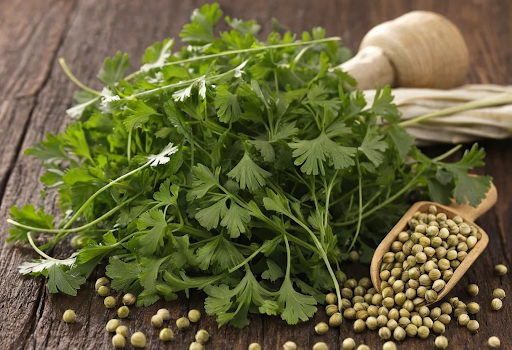
How to Properly Store Coriander Seeds
Table of Contents
ToggleHow to Properly Store Coriander Seeds
To select the optimal coriander seeds look for those with light brown coloring and a rough texture and an intense citrus scent. Age of seeds leads to the development of unpleasant musty or rancid smell.
The proper storage of Coriander seeds allows an extended shelf life and the best quality remains when these seeds are kept within cool dark spaces. Refrigeration preserves the shelf durability of particularly in hot and moist environments.
Clean and Dry
Knowing succulent decay indicators is fundamental to preserve these essential cooking spices because improper drying and collection of coriander reduces their preservation capacity. Spoiled seeds develop a rancid odor alongside an unappealing flavor so you should immediately replace them and discard them altogether.
The proper time to collect coriander seeds is when they emerge as light brown while still being ready to detach from the plant. Seeds reach their peak quality after bloom and a proper waiting period of several weeks is required before harvesting to achieve the best results; premature seed collection might result in immature underdeveloped under-flavored seeds with lower potency.
The initial cleaning phase begins with foreign materials discard and next involves seed soaking in distilled water for 10-15 minutes to enhance both effectiveness and purity of the cleaning procedure.
The drying process should end when the seeds become completely dry and you need to check potency by breaking open one seed to inspect its fragrance. You must eliminate any seeds from the coriander batch that possess unpleasant or rancid scents because they signal spoilage.
Remove the Husky
The dried seed pods known as Coriander seeds (Coriandrum sativum) bring a warm citrus taste highlighted by nutty notes to foods because these seeds contain many antioxidants which help digest food and make immune systems strong.
To maintain the freshness and flavor of coriander seeds proper cleaning treatments as well as curing techniques followed by storage methods become necessary. Proper drying and storage in airtight containers will preserve coriander seeds after freeing them from stalks and husks through mortaring or towel wrapping methods.
Storage of coriander seeds requires shielding them from windows since exposure to sunlight can cause widen the absorption of degrading odors throughout time. Regular inspections should be performed on these seeds because spoiled seeds will disappear both in taste and aroma as they age.
To confirm whether your coriander seeds maintain their useable state perform a germination test which will determine their viability. To determine seed viability spread a couple of seeds between wet paper towels or seed-starting mix that is damp; new growth in less than a few days means they still have potential while no growth reveals the seeds will no longer be safe for consumption.
Store in Airtight Containers
Airtight containers serve as the appropriate storage mechanism for coriander seeds. Proper storage containing airtight containers remains essential because light exposure together with air contact can severely affect both quality and flavor of your coriander seeds. Glass jars with appropriate sealing lids represent the best storage option for these purposes because they stop moisture from entering. Using opaque containers will block all light to protect your seed containers from light exposure. Each jar should contain silica gel packets which decrease seed-damaging humidity and enhance their longevity.
“The life duration of coriander seeds extends during refrigeration, but careful handling during removal is necessary to avoid condensation formation. Regular visual checks combined with taste tests help you identify seed freshness. On Metatrek, we emphasize the importance of replacing seeds when their odor becomes unpleasant or when their color turns faded and their appearance looks wilted.”
You should collect coriander seeds on dried up days after your flowering tops become brown. Placing seed-bearing coriander stems in your garden over winter allows pollinators together with pest-managing ladybugs to find safety for winter. Wet leaves need to dry using a salad spinner then users should bundle them into tight groups to store until ready in a dry cool area.
Store in a Cool Place
The proper storage for coriander seeds includes placing them in a cold area protected from moisture and light exposure to prevent quality deterioration. Glass jars together with tight lids or resealable plastic bags serve as suitable storage solutions for coriander seeds. It is important to label your storage containers so you can monitor expiration dates or order more when needed.
The protection of volatile oils in coriander seeds depends heavily on keeping humidity below 60% so humidity controls play a vital role in storage. Those living in humid regions should add desiccant packets into storage containers protecting coriander seeds because high moisture levels cause rapid deterioration together with mold growth. Proper storage methods in refrigerators can lengthen shelf life yet users must exercise caution about cold condensation formation when taking the products out of storage.
Ground coriander seeds remain effective for 3-4 years when stored properly yet freezing the seeds proves an optimal solution that adds 2-3 years to their storability. Putting coriander seeds safely in the freezer requires removing stems with seed heads and letting them dry completely then putting them into sealed freezer bags or containers.
Read also:Coriander Seeds (Coriandrum Sativum)
You may also like
Archives
Calendar
| M | T | W | T | F | S | S |
|---|---|---|---|---|---|---|
| 1 | 2 | 3 | 4 | 5 | 6 | |
| 7 | 8 | 9 | 10 | 11 | 12 | 13 |
| 14 | 15 | 16 | 17 | 18 | 19 | 20 |
| 21 | 22 | 23 | 24 | 25 | 26 | 27 |
| 28 | 29 | 30 | ||||
Leave a Reply